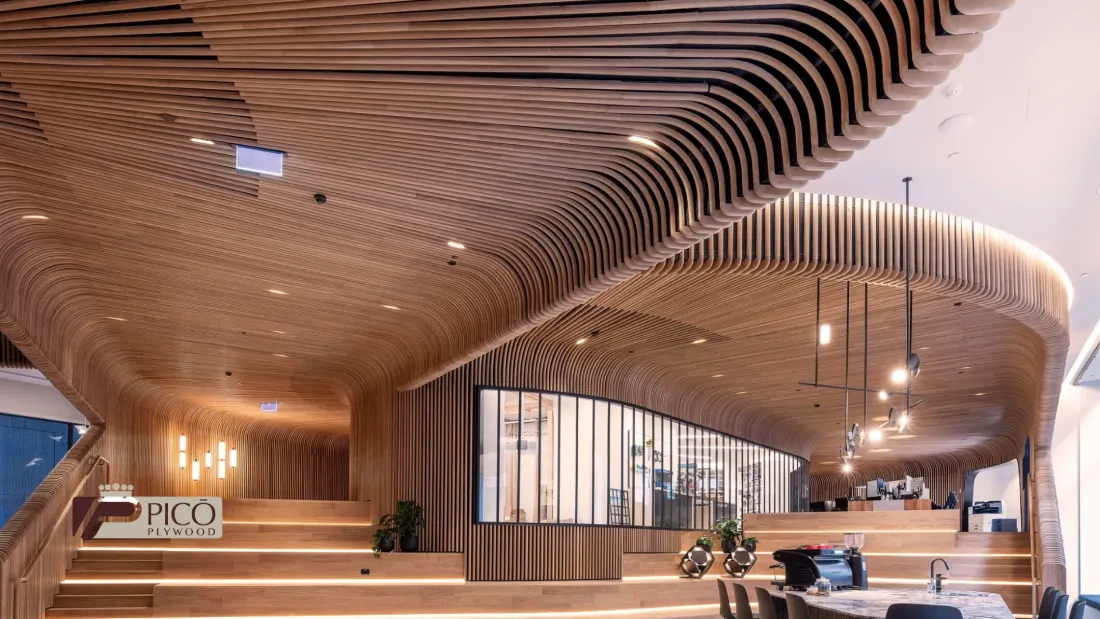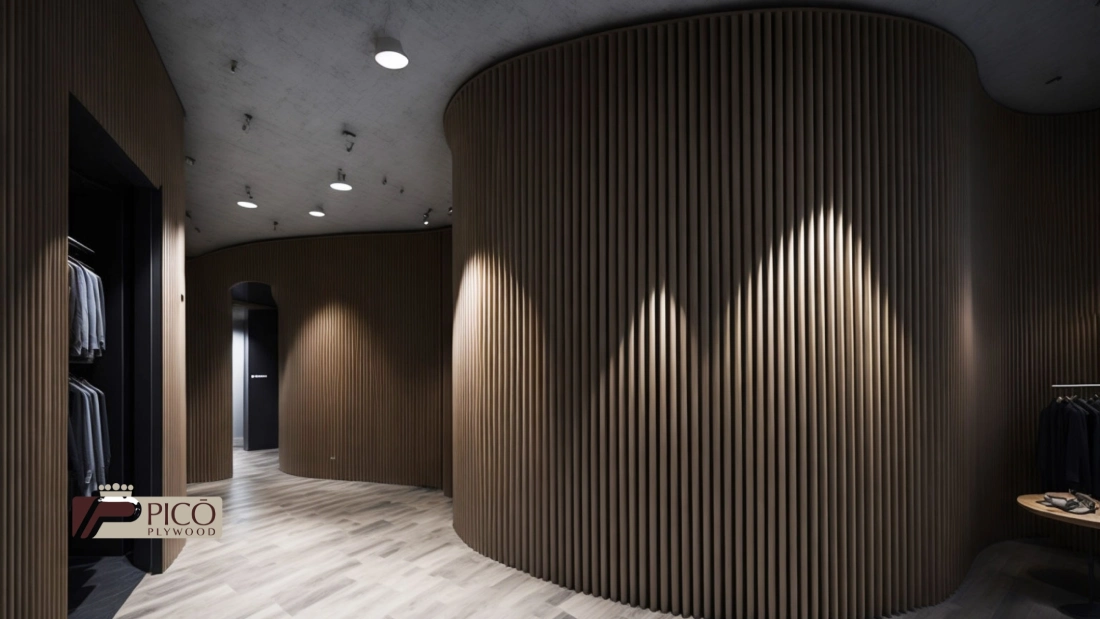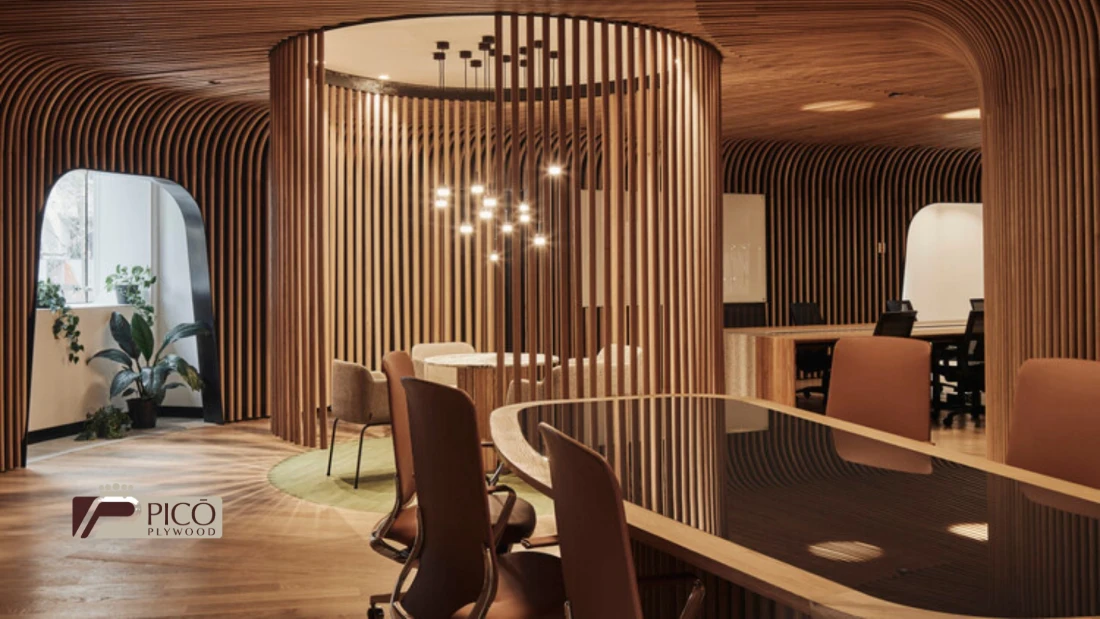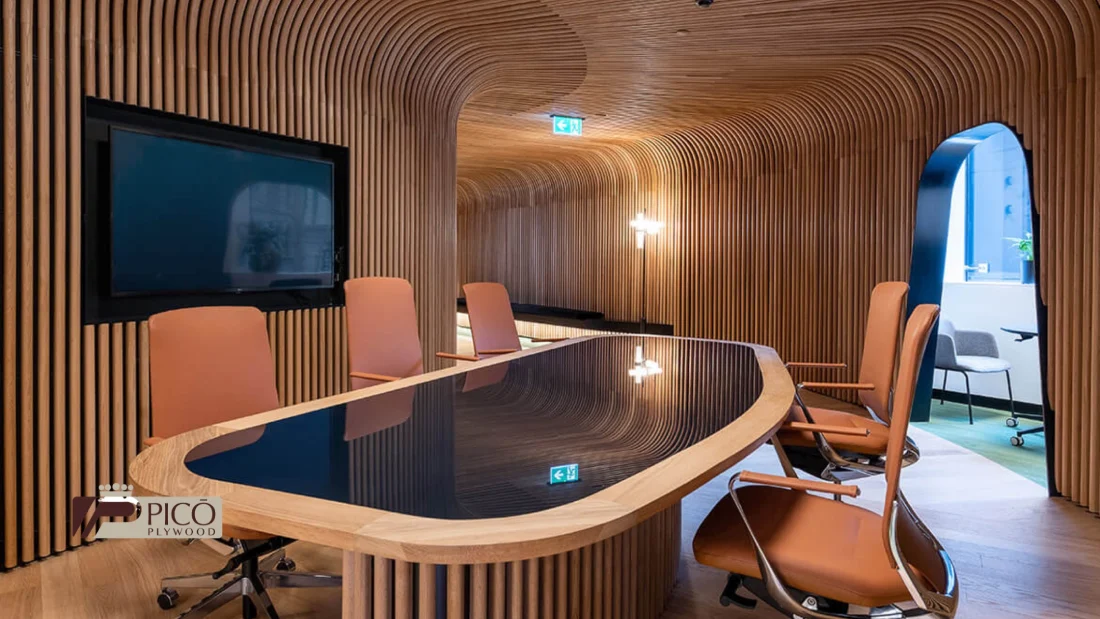pico Plywood Contact
Contact Information
To learn more about our Plywood Products or discuss your project requirements, please reach out to us through the following channels.

Table of Contents for the Article
Flexible Plywood has revolutionized the world of design and furniture manufacturing thanks to its unique properties. Unlike traditional plywood, this material allows for the creation of curved shapes and innovative designs without compromising strength or durability. Its versatility makes it an ideal choice for interior design, decoration, and custom furniture projects.
Flexible Plywood, also known as bendable plywood, is a type of wood panel specifically designed to bend easily without breaking or losing its structural integrity. It is manufactured using wood veneers with a special fiber arrangement, allowing it to curve effortlessly in both longitudinal and transverse directions.
Thanks to this design, it is an ideal solution for projects requiring curved surfaces or organic shapes, such as contemporary furniture, decorative paneling, and innovative architectural elements.
Flexible Plywood stands out for three main characteristics:
Its ability to adapt to curves and complex shapes without fracturing makes it perfect for cutting-edge designs.
It is lighter than other types of plywood, making it easier to handle and transport.
It can be cut, sanded, and assembled with ease, allowing for the creation of complex structures without the need for specialized machinery.
The use of Flexible Plywood in interior design and furniture projects offers multiple advantages:
Enables the creation of furniture and decorative elements with curved and organic shapes, opening up new creative opportunities.
Can be coated with laminates, natural wood veneers, or paint to achieve different styles and aesthetics.
Its efficient manufacturing process optimizes resource use and reduces material waste compared to other curved furniture construction methods.
Despite its flexibility, it is a robust and stable material, making it ideal for long-term applications.
In the following sections, we will explore how to use Flexible Plywood in furniture projects, the different types available, and the best techniques to maximize its potential in interior design. 🚀

Flexible Plywood is an innovative choice in furniture and interior design, thanks to its properties that combine aesthetics, functionality, and ease of handling. Its ability to adapt to curved and organic designs makes it an essential material for modern and sophisticated projects.
One of the main advantages of Flexible Plywood is its exceptional structural flexibility. Unlike traditional plywood, this material allows for smooth curves without the need for additional cuts or joints. This makes it ideal for:
Its adaptability encourages experimentation with new styles and concepts, expanding customization possibilities in furniture and interior spaces.
Although its flexibility might suggest fragility, Flexible Plywood is surprisingly strong and durable. Its layers of wood are strategically arranged to provide structural stability without compromising flexibility.
This makes it a reliable alternative for everyday furniture that requires both aesthetics and functionality.
Flexible Plywood is a highly manageable material, making it easy to cut, assemble, and adapt to different types of projects.
Can be worked with standard woodworking tools without risk of chipping or breaking.
Compatible with different fastening techniques, such as adhesives, screws, or staples.
Can be bent and adjusted manually or with the help of molds and templates, allowing for custom-made pieces.
This makes it ideal for both professional designers and carpenters, as well as DIY enthusiasts looking to create unique furniture without the need for specialized tools.
Another major advantage of Flexible Plywood is its compatibility with a wide range of finishes and materials. Its surface can be customized to match any decorative style.
Thanks to its flexibility, strength, ease of handling, and versatility in finishes, Flexible Plywood is an ideal material for creating innovative and elegant furniture. In the following sections, we will explore specific applications and examples of its use in furniture and interior design projects. 🚀
Flexible Plywood has revolutionized furniture design, enabling the creation of pieces with curved, fluid, and modern shapes that would be impossible to achieve with more rigid materials. Its versatility makes it an ideal option for designers and manufacturers looking to innovate in both the aesthetics and functionality of furniture.
Curved chairs and seats are among the most popular uses of Flexible Plywood. Its ability to adapt to ergonomic shapes allows for the design of furniture that combines comfort and style.
Flexible Plywood allows for the design of tables and desks with smooth forms and no sharp corners, providing both safety and a modern, elegant aesthetic.
Flexible Plywood is not only used for furniture structures but also as decorative cladding that adds texture and volume to spaces.
Flexible Plywood allows designers to experiment with form and space to create shelves and room dividers with organic lines that transform the layout of any space.
Thanks to its ease of handling, cutting, and assembly, Flexible Plywood is perfect for custom designs and modular furniture that can adapt to different needs and spaces.
Flexible Plywood expands the possibilities of furniture design, allowing for the creation of ergonomic, modern, and functional pieces. Its ability to adapt to curved and structural forms makes it an ideal choice for designers looking to innovate in the furniture and interior design industry.
🚀 In the next section, we will explore key tips and techniques for working with Flexible Plywood to achieve optimal results in every project.

Flexible Plywood not only revolutionizes furniture design but also serves as a key material in interior design. Its ability to adapt to curved and fluid shapes makes it an ideal choice for cutting-edge projects, from wall cladding to decorative structures in homes, offices, and commercial spaces. Below, we explore its main applications in interior design.
Curved cladding with Flexible Plywood adds a dynamic and elegant visual effect, ideal for spaces seeking an innovative and immersive design.
Flexible Plywood enables the creation of unique decorative structures, adding depth and character to interior spaces.
In commercial interior design, Flexible Plywood has become a key material for creating bars, counters, and customer service areas with innovative shapes.
Flexible Plywood allows for innovation in door and wardrobe front design, resulting in more aesthetic and functional surfaces.
High-end spaces, such as hotels, prestigious offices, and luxury residences, use Flexible Plywood to add sophistication and exclusivity to their interior designs.
Flexible Plywood offers a wide range of applications in interior design, enabling the creation of modern, innovative, and functional spaces. From curved cladding to custom decorative elements, this material opens endless possibilities for architects and designers looking to differentiate their projects.
🚀 In the next section, we will explore the techniques and key tools for working with Flexible Plywood and achieving professional finishes in every application.
Flexible Plywood is a versatile and easy-to-handle material, but it requires specific techniques to ensure an optimal finish and long-lasting durability. In this section, we will explore best practices for bending, cutting, assembling, and protecting it while avoiding common handling mistakes.
One of the greatest advantages of Flexible Plywood is its ability to adapt to curved shapes, allowing the creation of fluid and organic designs. However, it is essential to apply curvature correctly to prevent cracks or weakening of the material.
Avoid excessive heat application, as it can weaken the wood structure or create cracks on the surface.
To achieve precise cuts and secure assembly, it is essential to use the right tools and follow certain recommendations to optimize the working process with Flexible Plywood.
When cutting Flexible Plywood, apply masking tape over the cut line to reduce the risk of splintering on the surface.
The right finish not only enhances the appearance of Flexible Plywood but also protects the wood from moisture, wear, and other environmental factors.
Apply the finish on both sides of the board to prevent deformation due to uneven moisture absorption.
Despite its ease of use, Flexible Plywood can present issues if not handled correctly. Here are some common mistakes and how to avoid them:
❌ Bending it abruptly without proper support
✅ Use molds or progressive fixations to achieve curvature without damaging the structure.
❌ Cutting with inappropriate tools that cause splinters
✅ Use fine-tooth saws and apply masking tape over the cut line to prevent splintering.
❌ Applying finishes without prior sanding
✅ Lightly sand the surface before applying varnish, paint, or sealant for a uniform result.
❌ Not reinforcing joints in load-bearing structures
✅ For furniture and structural elements, reinforce with wooden beams and high-strength adhesives.
Always test on a sample piece before applying any cutting, bending, or finishing technique to the final material.
Working with Flexible Plywood allows great creative freedom in furniture and interior design, but it requires the use of specific techniques to achieve the best results. With proper bending, the right tools, and protective finishes, this material can transform any project into a functional and aesthetic masterpiece.
🚀 In the next section, we will explore successful project examples and how design professionals have used Flexible Plywood to create innovative and unique spaces.

Flexible Plywood not only stands out for its versatility in furniture and interior design but also for its contribution to sustainability and alignment with modern trends in architecture and decoration. Thanks to its efficient use of resources and adaptability to organic designs, this material is a key option for those seeking innovation without compromising environmental responsibility.
One of the most important factors today is the sustainability of materials used in furniture and cladding production. Flexible Plywood is an eco-friendly choice for several reasons:
✅ Reduced wood waste: Its composition allows for better raw material utilization, minimizing waste compared to other types of wood.
✅ Efficient use of adhesives and treatments: Many flexible panels are manufactured with eco-friendly adhesives that reduce volatile organic compound (VOC) emissions, improving indoor air quality.
✅ Lower environmental impact: The production of Flexible Plywood consumes less energy than synthetic materials, and its extended durability reduces the need for frequent replacements.
To ensure that the Flexible Plywood used comes from responsible sources, it is essential to check for certifications such as:
Before selecting Flexible Plywood for a project, verify that it has environmental certifications supporting its origin and composition.
Interior and furniture design is evolving towards more fluid and organic styles, where flexible wood plays a fundamental role. For 2025, the following trends will dominate the industry:
🔹 Curved furniture without sharp edges: Soft and flowing lines provide an elegant and welcoming style to any space, improving ergonomics and visual comfort.
🔹 Nature-inspired designs: Natural materials and organic shapes mimic environmental patterns, integrating biophilic elements into interiors.
🔹 Warm minimalism: Unlike traditional minimalism, this trend incorporates curved wood elements to create cozier and less rigid spaces.
🔹 Modular and multifunctional spaces: The flexibility of Flexible Plywood enables the creation of adaptable furniture that can be rearranged according to user needs.
🔹 Natural tones and matte finishes: The aesthetic trend leans towards light woods, satin finishes, and subtle textures that highlight the material’s natural beauty.
A clear example of this trend is the use of curved headboards, ergonomic chairs made from flexible wood, and wavy wall panels in modern hotels and homes.
Flexible Plywood is key in the transition towards more efficient and sustainable interior design. Its advantages include:
✅ Lower material consumption: Its structure allows for optimized cuts and minimal waste in furniture and cladding manufacturing.
✅ Greater efficiency in transportation and storage: Its ability to bend reduces costs and required space for transport compared to other rigid materials.
✅ Reduced use of synthetic elements: In many projects, Flexible Plywood replaces plastics or other less sustainable materials, promoting the use of renewable resources.
✅ Long lifespan and easy recycling: It is a highly durable material, and at the end of its useful life, it can be recycled or repurposed for new projects.
In the design of sustainable coworking spaces, Flexible Plywood is used to create curved room dividers, modular desks, and warm cladding without the need for additional structures, reducing the project’s carbon footprint.
Flexible Plywood not only allows for unprecedented creative freedom but also meets today’s demands for sustainability and efficiency in interior design. Its ability to adapt to emerging trends and its reduced environmental impact position it as an essential material in the architecture and furniture of the future.
🚀 In the next section, we will explore how to apply these concepts in real projects and inspiring examples of designs using Flexible Plywood.
Flexible Plywood has revolutionized the world of furniture and interior design thanks to its versatility, durability, and aesthetic appeal. Its ability to adapt to curved shapes and its ease of handling make it an essential material for innovative and sustainable projects.
From curved furniture and decorative cladding to architectural structures and custom elements, Flexible Plywood offers functional solutions without compromising creativity.
🔹 Structural flexibility: Enables the creation of curved and fluid designs that would be impossible with conventional wood.
🔹 Durability and resistance: Suitable for daily-use furniture and high-traffic applications.
🔹 Compatibility with finishes and other materials: Can be painted, varnished, or combined with other elements for a perfect finish.
🔹 Diverse applications: From chairs and desks to wall and ceiling cladding, counters, and room dividers.
🔹 Sustainability and efficiency: Made from certified wood and designed to reduce material waste.
An architecture studio can use Flexible Plywood to create curved walls in a modern office, achieving an innovative design with a low environmental impact.
At Picó Plywood, we offer a range of high-quality Flexible Plywood panels designed to meet the needs of designers, architects, and furniture manufacturers. Our products meet sustainability standards and guarantee resistance, aesthetics, and ease of use in any application.
🔹 Explore our collection: From standard flexible panels to customized options for specific projects.
🔹 Variety of finishes: Choose from different thicknesses and treatments to tailor the material to your design.
🔹 Quality assurance: Our materials are certified to ensure optimal performance in every application.
📍 Discover more on our website: www.picoplywood.com
Every project is unique, and choosing the right material is key to its success. At Picó Plywood, we have a team of experts ready to help you select the ideal Flexible Plywood for your design needs.
✔ Do you have questions about which panel to choose?
✔ Do you need recommendations for cutting and finishing?
✔ Do you want to learn the best assembly techniques?
📞 Contact us for personalized advice and take your ideas to the next level with the best Flexible Plywood on the market.
🌱 Opt for an innovative, sustainable, and functional design.
🎨 Explore new shapes and textures with flexible wood.
📢 Visit us at www.picoplywood.com and find the perfect solution for your project.
✨ Trust Picó Plywood and bring your ideas to life without limits! ✨
pico Plywood Contact
Contact Information
To learn more about our Plywood Products or discuss your project requirements, please reach out to us through the following channels.
Plywood supplier, Plywood boards, Veneered plywood panels, Special Plywood
Contact information

Esta web utiliza cookies para que podamos ofrecerte la mejor experiencia de usuario posible. La información de las cookies se almacena en tu navegador y realiza funciones tales como reconocerte cuando vuelves a nuestra web o ayudar a nuestro equipo a comprender qué secciones de la web encuentras más interesantes y útiles.
Strictly necessary cookies must always be enabled so that we can save your cookie setting preferences.
If you deactivate this cookie we will not be able to save your preferences. This means that each time you visit this website you will have to activate or deactivate cookies again.
Esta web utiliza Google Analytics para recopilar información anónima tal como el número de visitantes del sitio, o las páginas más populares.
Dejar esta cookie activa nos permite mejorar nuestra web.
Please enable strictly necessary cookies first so we can save your preferences!